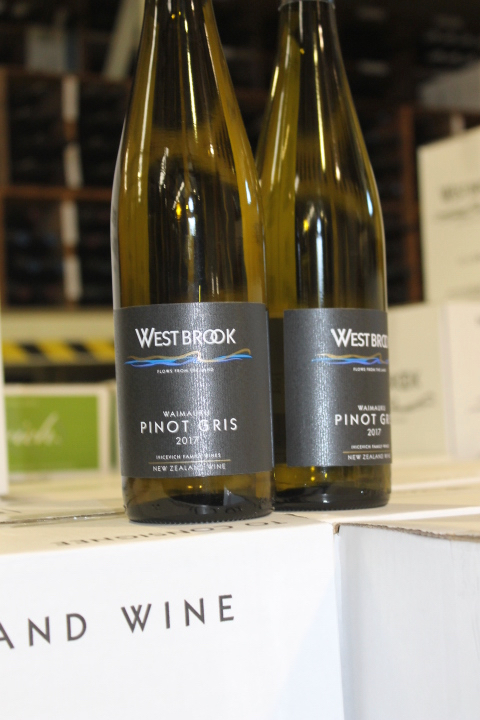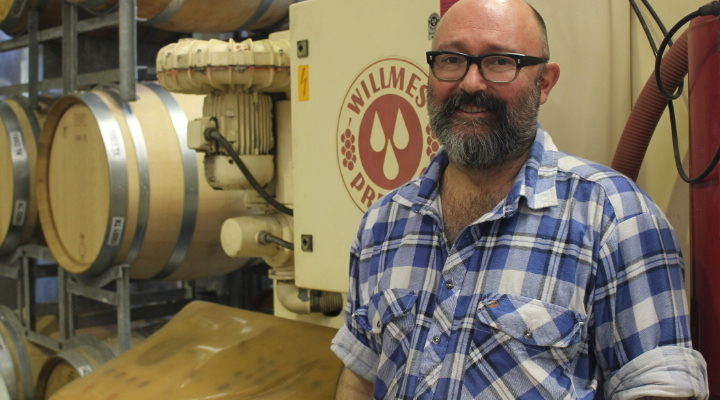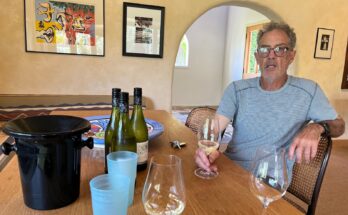
An occasional series where we corner the best of New Zealand’s winemaking talent. Starting with James Rowan.
Tough start to a day at the office – sun streaming through shutters at the winery at the top of the hill on a bright Spring morning. To be fair, James has been hard at it since 6am; with wines starting to come out of barrel, there’s work to be done – and assistant Winemaker Renée Dale seems happy to see me arrive and cue a break in the barrel cleaning…
Quick hellos to other early morning staff at the winery and a toodle around the barrels – I’m instantly caught by the different labels on the oak – and have to ask James how many wines they make. The answer, whilst mildly confidential, is surprising – and “everyone has a rosé” he laughs. To say that I’d been somewhere in the last week, and had what I thought was an admirably fine wine given the location’s stellar reputation for things other than wine.. and find out it was made here, by James’ team – I was surprised, but not surprised.
Long lines of tanks “are hardly used these days” as the requirements for James’ skills in making drinkable Sav decline. Well regarded (and awarded) for the spectacular Rieslings he can produce; but we both agree that the future is in other varietals – the chardonnay of course, but scope to do more with syrah, in particular.

We start off discussing how much winemaking is ‘creative’ or ‘scientific’. With 15 years at Westbrook, learning from the Ivicevich family, James is still first in line at “dragging the lines at Vintage, remembering the physical process of making wine. You’re making quite big steps at the beginning and you don’t want to create an issue where you can’t do anything you want, further down the path. To be truly creative, one first has to know the science behind your craft.” In the vineyard “you just taste – eventually you’ll bring in one sample to test, but you’ve already worked it out on the palate. I used to laugh about it myself as young fella – the old men going through the vineyard tasting the fruit.. but that is exactly what you do. You look at it, and you taste it. And you don’t pick on sugar levels – you pick on taste. People say you can’t taste pH – I think you can – I can. You can also tell whether the grapes are ready or not in other ways – the skin texture.. the vine will tell you if it’s time to pick – rule 1 ‘Always pick with a green canopy’.”
James adds that as well as the steps that are followed “we do end up having a stylistic bent to ourselves” Even as a beginner his father could pick out, from blind tasting, the wines James had made: “they had my handprint on them, Dad used to say”. Whilst not feeling the pinch of commercial necessity too fiercely – Westbrook can make “two styles of chardonnay – the Waimauku and the Barrique Fermented: and one will have lots of oak, certainly some malo – got a breadth to it rather than a searing acid focus – but the other can be as austere as we like, because we only make 20 barrels of it – lovely low-cropped fruit and it will be beautiful anyway. We do it under own steam – don’t have a big marketing company, and anyway marketing wine is very different from making wine.”
On winning awards, James is clear “it has helped us in the past – I get a bit cynical about it, and I’m a Senior Judge! It’,s nice to have some gold medals on the bottle – we had a Waimauku Chardonnay that had eight gold medals on it at one point – and it used to be that if it had a gold medal on it – it would sell out; and you’d hope that that one winner would help shed light on the house it came from – you have a whole portfolio of wines. I’m a huge fan of Silver medals – they tend to be more stylistic. But competitions, critics, magazines – they all have a part to play.”

We chatted about Brexit, Boomers and democracy before circling back to ideas in winemaking. “You only ever get to try the great examples of something – never the experimental ones. When you’re a contract winemaker, you can’t just say ‘we’re going to make them all this way’ – you have a moral responsibility to making good, clean wine – to massage it along the way.”
The ‘Lighter Wine’ project also came up in conversation. I, personally don’t drink wine to get drunk – I love wine and often wish it wasn’t alcoholic at all. “Making lighter wines viticulturally, rather than spinning cone technology – again, there is science involved – but alcohol carries different aromatics and flavours, and has a sweetness about it. You get these Cote du Rhone and ChateauNeuf wines from the superhot 2015 & 2016 vintages; so the brix and alcohols and pH are all high – ending up with a hot, soapy wine and the alcohol’s out of balance”.

Talk turns to Chardonnay, of course. We taste through some wines – starting with the 2016 Waimauku Chardonnay “We make 20 barrels or so, and the first crop off these vines was 2004 – we get quite vibrant flavours off these ‘teenage’ vines. You get different structures from different ages – wines from Waiheke, we saw the tannin structures change at ten years, but I’m very much an old vine fan. Older vines also help us through hard vintages, they’ve got the reserves there and the fruit doesn’t become so fragile. Our fruit here is low-cropping and is hand-picked – we can’t use a machine here. Rather than whole-bunch press our chardonnay, we crush and press it – there’s a time factor on that – and I actually like the extraction we get from the skins, even though we then juice-fine… we don’t often do wine-fining. Just to take those rough edges off – then once it’s gone through the process you are just playing in the shadows at the end. The lightest polish, and it’s worked brilliantly for us.”

“2017 was a difficult year, but we worked through it. It looks a little bit different, and deeper, little bit smokey – the smokiness isn’t actually oak, it’s from the fruit. We get an interesting almost roast fennel character here. In 2010 everything had this anise flavor – across all the varietals – the Pinot Gris, Pinot Noir, Chardonnay, Malbec. The Pinot Noir looked Rhone-ish – the vines had gone deep into the clay and pulled out some saline characters. We haven’t released this (the ’18 Chardonnay) yet. I do like acidity, it just helps to carry the wine through. Our first wine, the 2004 had searing acidity, we loved it! And for 2008 we decided to just make one wine – too often you’re taking reserve material out; and of course that wine won all those gold medals.”
“2018 challenging again, but a stylish wine – quite tight and closed, it may take a while to open up. Like the Kumeu River Matés Chardonnay that has that lovely acid line, the citrus acidity – I want to see that tightness! We can get slightly obsessed about drinking young wine. This has a lot going on”. Renée recalls “walking through the vineyard and tasting the Clone 95 Chardonnay and tasting lemons and hazelnuts, whilst eating the grapes….it was bizarre!”
On experimentation.. “we do look at barrel coopers – some say oak is a flavouring; but it’s got to suit the fruit you are doing it with. Each of the coopers have that different phenolic structure, different forests. You’re trying to sculpt a palate line and we made a couple of changes to the cooperage we were using – when you’re blending even 2% makes a huge difference. Using maybe 20 barrels, and 20% new oak – one barrel extra can make quite a difference.”
Earlier we’d touched on the number of rosé wines around. James chips in that they “make one for every client we make wine for. The volumes have just been increasing and increasing. I drink it all day, all night, summer and winter – I love rosé! Especially the style we’re making it, where it’s got tannin and acid. A freshness, a little bit of sweetness. I say Riesling’s like a gin and tonic – well, rosé is a pink gin and tonic, isn’t it?”
I like to talk to people about story telling, and the importance that I think it still has in modern life. James seems like a kindred spirit. “Everything’s got to be put into a context. Another winemaker once said ‘don’t send people a bottle of wine, take a bottle of wine to them’ so that you’re sitting there telling that story. Because it is your story.” I talk about the story behind the wines; and great stories like Sir George Fistonich – but even a story like Villa Maria has a context. “Any winery that has market issues in their history, especially financial struggles – they don’t want to go through that again. Look at Delegats and Villa Maria… and they’ve both gone in and said ‘right, we’re doing this’ and look at those two businesses! And they support each other as well.

“Wines are never just that moment – well, they are obviously… but it transfers into something else, somewhere else. Here in the winery – this is where we benchmark and taste. I was doing some syrah blending and took some samples home just to see how it evolved over the night.”
“We’re quite big on the people we work with. You just have to trust everyone to do their job. Because you can’t be everywhere. So Brick Bay, Soho… they supply the fruit, doing the best job they can; and we do the best job we can. That’s the only way you can do it. Sometimes the juice comes up to us and we just do our bit. We do try to keep wines slightly different. Our Rieslings – I like acid and I like sugar – look at the 2018 and 2019 – they are both about 18g of residual sugar, both about 11 and a half-ish alcohol, pH both about 2.7, 2.8. pH can change the texture of the palate – it’s how we make wine, it’s so important. Wine, like life, is about texture – I believe that strongly.”

I wanted to discuss the influence of other wines, and being a judge, tasting lots of other people’s wines. First James: “We taste a lot of wine, well, I do. But when were making our wine it’s not relevant – it won’t be there next to it when we’re blending.” Then Renée adds “ultimately it comes down to ‘do you like that being on your palate’. We’ve spent so many hours talking about what we could do here and there – different ferments and barrels and whatever; and then when we actually get to the crunch, we go ‘do we like it?’




